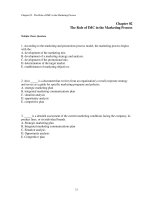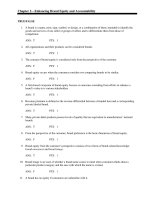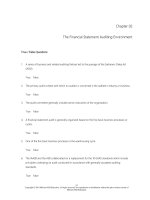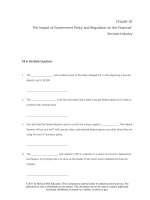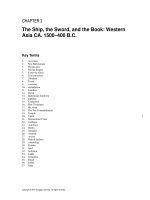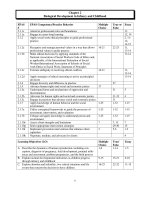Beginnings and beyond foundations in early childhood education 9th edition gordon test bank
Bạn đang xem bản rút gọn của tài liệu. Xem và tải ngay bản đầy đủ của tài liệu tại đây (253.18 KB, 12 trang )
CHAPTER 2—TYPES OF PROGRAMS
TRUE/FALSE
1. Early childhood programs reflect the needs of society.
ANS: T
2. Early childhood programs are similar in their educational goals and practices.
ANS: F
3. Full-day child care is a modern phenomenon.
ANS: F
4. Good, affordable, accessible child care is readily available for all of today’s families.
ANS: F
5. DAP refers to an academically rigorous early childhood program.
ANS: F
6. “Cultural appropriateness” is the ability to integrate a child’s ethnic background into the mainstream of
American life.
ANS: F
7. Most family child care homes are licensed.
ANS: F
8. National licensing standards exist for all early childhood programs.
ANS: F
9. Parent cooperatives no longer exist.
ANS: F
10. Head Start began as part of the government’s War on Poverty in the 1960s.
ANS: T
11. The age range among children in mixed-age groups is usually about one year.
ANS: F
© 2012 Cengage Learning. All rights reserved.
12. According to the The Children of the Cost, Quality, and Outcomes Study Go to School study, children
who were at risk gained the most from positive child care experiences.
ANS: T
13. Head Start was established in 1994 as part of the Head Start Reauthorization Act.
ANS: F
14. All 50 states require offering a full-day kindergarten.
ANS: F
15. Wages are an important consideration of quality child care.
ANS: T
MULTIPLE CHOICE
1. Developmentally appropriate practice (DAP) is based on ____.
a. what a teacher knows about child development
b. what a teacher knows about an individual child
c. what a teacher knows about the child’s social and cultural background
d. All of these are correct.
ANS: D
2. The most important determinant of a good program is ____.
a. quality and compensation of staff
c. indoor and outdoor environment
b. the curriculum
d. health and safety of children
ANS: A
3. A core principle of the traditional nursery school is ____.
a. social competence
b. free play for long periods of time
c.
c. balance of active/quiet play
d. All of these are correct.
ANS: D
4. Child care always differs from other programs in ____.
a. length of day
c. training of staff
b. curriculum
d. philosophy
ANS: A
TB-16
© 2012 Cengage Learning. All rights reserved.
5. Quality child care focuses on ____.
a. curriculum
b. wages
c. size of playground
d. parent involvement
e. All of these are correct.
ANS: E
6. For 1.7 million the chosen option for child care is ____.
a. nursery school
b. laboratory school
c. family child care
d. grandparents
e. nanny
ANS: C
7. Laboratory schools ____.
a. housed at a college or university
b. participate with teacher training
c. focused on research
d. provided educational models
e. All of these are correct.
ANS: E
8. The largest single provider of child care in the United States is ____.
a. the government
c. public school districts
b. churches
d. colleges and universities
ANS: B
9. Head Start has been a leader in ____.
a. diversity/multicultural/multiracial education
b. research
c. curriculum
d. Religion
e. Both A and C are correct.
ANS: E
10. Looping is ____.
a. a game to help children learn coordination
b. considered stressful for children
c. the practice of keeping children and their teacher together for at least two years
d. a new name for parent-teacher conferences
ANS: C
TB-17
© 2012 Cengage Learning. All rights reserved.
11. Advantages of mixed-age grouping include ____.
a. social skills are enhanced
b. sense of community is fostered
c. children’s developmental levels are taken into consideration
d. older children will help younger children
e. All of these are correct.
ANS: E
12. The lasting effects of a quality early childhood program have been the subject of several research
studies. These studies seem to indicate that children who are enrolled in high-quality programs ____.
a. have better social and cognitive skills, and earn more money as adults
b. are likely to have more children
c. receive more special education
d. are likely to become early childhood educators
ANS: A
13. The primary reason parents choose homeschooling over public or private schooling is _____.
a. greater potential for a better education
b. religious philosophy
c. public schools provide poor learning environments
d. financial concerns
ANS: B
14. Which of the following is NOT cited by educators as a concern regarding homeschool educational
programs?
a. too much focus on the arts
b. lack of uniformity in regulations
c. lack of socialization opportunities
d. too great a time commitment is demanded of parents
ANS: A
15. A need early childhood programs meet is _____.
a. caring for children while parents work
c. academic or readiness instruction
b. an activity arena for children
d. All of these are correct.
ANS: D
16. Programs evaluations are based on which of the following steps?
a. define objectives
c. choose an instrument
b. implement the findings
d. All of these are correct.
ANS: D
17. The Perry Preschool Project is noteworthy because it was _____.
a. the first study to track children to age 27 c. a new curriculum
b. an evaluation of teacher credentials
d. None of these are correct.
ANS: A
TB-18
© 2012 Cengage Learning. All rights reserved.
18. A good infant/toddler program will differ from preschool education in _____.
a. providing one on one care
c. inconsistent communication with parents
b. delayed adult responses
d. high staff turnover
ANS: A
19. According to Hyun, cultural congruency can be addressed through _____.
a. devaluing objects from home
b. relationships between home and school learning
c. ignoring certain groups of individuals
d. undermining children’s personal experiences
ANS: B
20. Common factors among all early childhood programs are _____.
a. age of children served
b. philosophical ideals
c. staff education
d. All of these are correct.
e. None of these are correct.
ANS: E
21. Program evaluations include an assessment of _____.
a. performance and behavior
c. plans for the future
b. areas of difficulty
d. All of these are correct.
ANS: D
22. Agencies that sponsor early childhood programs are _____.
a. NAEYC
c. social services
b. state agencies
d. All of these are correct.
ANS: D
23. “Redshirting” is often justified by _____
a. parent’s desire for the child to be 6 when they enter Kindergarten
b. failing a child in Kindergarten
c. passing a child because he is too old to be in Kindergarten
d. None of these are correct.
ANS: A
24. Issues that affect quality in a child care center are _____.
a. cost and classroom size
c. staff turnover and low wages
b. staff/child ratio and class materials
d. playground equipment and cost
ANS: C
TB-19
© 2012 Cengage Learning. All rights reserved.
MATCHING
Match the description with the type of program.
a. Parents run the school
e. Housed in churches/synagogues
b. Takes place in child’s home
f. Required in 41 states
c. A comprehensive program
g. Parents are teachers
d. Recognizes the child’s “personhood”
1.
2.
3.
4.
5.
6.
7.
Faith-based programs
Home schooling
Nannies
Head Start
Kindergarten
Infant/toddler care
Parent cooperatives
1.
2.
3.
4.
5.
6.
7.
ANS:
ANS:
ANS:
ANS:
ANS:
ANS:
ANS:
E
G
B
C
F
D
A
8.
9.
10.
11.
ANS:
ANS:
ANS:
ANS:
D
C
A
B
Match the appropriate descriptions with the names.
a. Quality, affordability, compensation
b. Fringe benefit
c. DCAP
d. Developmentally appropriate practices
8.
9.
10.
11.
NAEYC
Cultural congruence
Triple threats
Employer-sponsored child care
Match the program with the needs of the children.
a. Parent cooperative
d. Infant/toddler program
b. Church/synagogue-based program
e. Inclusive programs
c. Family child care
12.
13.
14.
15.
16.
Those with special needs
Those who need all-day care
Those who are under 2 years of age
Those whose parents want to be involved
Those with specific religious interests
12.
13.
14.
15.
16.
ANS:
ANS:
ANS:
ANS:
ANS:
E
C
D
A
B
Match the key practice with the definition.
a. Creating a caring community of learners
b. Teaching to enhance development and learning
c. Planning curriculum to achieve important goals
d. Assessing children’s development and learning
e. Establishing reciprocal relationships with families
17. Ongoing and monitors each child’s progress in meeting program goals
18. A balance of teacher-directed and child-initiated learning
19. Developing collaborative relationships with families
20. Supporting and valuing all children
21. The knowledge of how children learn
(problem continued on next page)
TB-20
© 2012 Cengage Learning. All rights reserved.
17.
18.
19.
20.
21.
ANS:
ANS:
ANS:
ANS:
ANS:
D
B
E
A
C
Match the theorist with the special program offerings.
a. mixed age grouping
b. looping
c. both mixed age grouping and looping
22.
23.
24.
25.
26.
27.
28.
Waldorf
Dewey
Reggio Emilia
Montessori
Piaget
Gardner
Vygotsky
22.
23.
24.
25.
26.
27.
28.
ANS:
ANS:
ANS:
ANS:
ANS:
ANS:
ANS:
C
A
C
C
A
A
A
Match the advantages and disadvantages to the following scenarios depicting family child care
homes.
a. advantage
b. disadvantage
29.
30.
31.
32.
33.
34.
35.
36.
37.
38.
39.
40.
Homes are unregulated
Providers often lack knowledge of child development
For children who do well in small groups
Known as a small in-home business
Consistency and stability from a single provider
Feeling of isolation
A way for men or women who want to stay home to make a little extra money
Flexible hours for families
Small and personalized
Articles are being published in professional journals
Professionalism is required
Star in the galaxy of child care options
29.
30.
31.
32.
33.
34.
35.
36.
37.
38.
39.
40.
ANS:
ANS:
ANS:
ANS:
ANS:
ANS:
ANS:
ANS:
ANS:
ANS:
ANS:
ANS:
B
B
A
A
A
B
A
A
A
A
B
A
TB-21
© 2012 Cengage Learning. All rights reserved.
Match the steps for assessment with the definition.
a. Set goals
b. Define expectations
c. Be inclusive
d. Define objectives
e. Choose instrument
41.
42.
43.
44.
45.
have been met in a system of mutual accountability
meaningful plan of action
ITERS
culturally appropriate
tailor to needs and characteristics
41.
42.
43.
44.
45.
ANS:
ANS:
ANS:
ANS:
ANS:
B
A
C
E
D
SHORT ANSWER
1. Choose five of the ten indicators of quality for programs for young children and describe briefly.
ANS:
The curriculum encourages children to be actively involved in the learning process, to
experience a variety of developmentally appropriate activities and materials, and to pursue
their own interests in the context of life in the community and the world.
Relationships among teachers and families are based on a partnership to ensure highquality care and education. Parents feel supported and welcomed as observers and
contributors to the program.
The program is staffed by adults who are trained in child and family development and who
recognize and meet the developmental and learning needs of children and families. They
recognize that the quality and competence of the staff are the most important determinants
of the quality of an early childhood program.
The indoor and outdoor physical environment is designed to promote optimal growth and
development through opportunities for exploration and learning. The quality of physical
space and materials affects the levels of involvement of the children and the quality of
interaction between adults and children.
Ongoing and systematic evaluation is essential to improve and maintain the quality of an
early childhood program. Evaluation should focus on the program’s effectiveness in
meeting the needs of children, families, and staff.
TB-22
© 2012 Cengage Learning. All rights reserved.
2. Describe at least five of the guiding principles that make Head Start a success.
ANS:
Its comprehensive nature views the child as a whole, requiring medical, dental, and
nutritional assessment as well as intellectual growth. Extensive health, education, and
social services were offered to children and their families from the inception of Head
Start. Head Start continues today to provide health and medical screening and treatment
for thousands of youngsters.
Head Start redefined the role of parents by expecting them to serve as active
participants. Parents are involved in the program at all levels: in the classroom as teacher
aides, on governing boards making decisions about the program, and as bus drivers and
cooks.
Head Start promoted community collaboration. Interest and support from the local
community helped Head Start respond to the needs of the children and families it served.
Since its inception, Head Start has sought to provide a curriculum that reflects the
culture, language, and values of the children in the program.
Head Start pioneered the inclusion of children with special needs and disabilities in its
classrooms.
3. What are the components of a successful after school program?
ANS:
Successful after school programs have the following components:
Flexible hours and schedules that match school calendars
Reasonable fees
Clear lines of communication with parents
Utilization of community resources such as libraries, swimming pools, and parks
Supplemental to and supportive of regular school programs rather than extending the
school day
Teaching staff is trained in operating extended programs for children
Homey, relaxed atmosphere
Large blocks of free play time
Children are self-directed, self-paced
Many opportunities for creative expression
Cooperation is stressed rather than competition
The program needs its own permanent space
4. What are the three criteria on which developmentally appropriate practices (DAP) are based?
ANS:
Knowledge of child development and learning
Knowledge of the strengths, interests, and needs of each individual child
Knowledge of the social and cultural contexts in which children live
TB-23
© 2012 Cengage Learning. All rights reserved.
5. Cite three examples of DAP in action in each of the following: (1) an infant/toddler program; (2) a
family child care home; (3) an after-school for kindergartners.
ANS:
1. Infant/toddler: variety of grasping toys; routines are viewed as learning experiences;
respects child’s need for solitary and/or parallel play
2. Family child care: Range of activities and materials for wide developmental age span; is
licensed; participates in child care training workshops
3. After school center: good use of community resources such as libraries and parks; large
blocks of time for free play; children are self-directed and self-paced
6. Define what is meant by developmentally and culturally appropriate practice.
ANS:
The ability to go beyond one’s own sociocultural background to ensure equal and fair teaching and
learning experiences for all children. Includes adult’s ability to develop a multiethnic perspective.
7. How does the evaluation process relate to the issue of high-quality programs?
ANS:
The process helps the assessor take an overview of the entire program. Rather than focus on the
achievements of one child or the performance of one teacher, a good evaluation process includes
curriculum development, parent’s involvement, the program’s relationship to the community, the
governance of the school, the financial structure, and the physical environment. This type of
integrated assessment gives greater awareness to areas in need of improvement, such as teacher’s
credentials and experience or staffing ratios that are often indicators of good-quality programs. A
key indication of a quality program is program evaluation.
8. What does triple threat mean?
ANS:
This phrase summarizes the three critical issues in child care today: the ability to provide quality
programs for children that are affordable for their families, and to provide adequate compensation
for the staff.
ESSAY
1. Choose one of the theoretical principles of developmentally appropriate practices applied to an
early childhood program and explain how the principle is used in that program type.
ANS:
Answers will vary, see page 42 for examples.
TB-24
© 2012 Cengage Learning. All rights reserved.
2. Describe the differing philosophies of early childhood program types.
ANS:
Answers will vary, but for each program type (child care centers, family child care homes,
Head/Start, and Early Head Start), the students should include the following:
Ages of the children being served
Philosophical, theoretical, or theological ideals
Goals of the program
Purpose for which the program was established
Requirements of sponsoring agency
Quality and training of teaching staff
Shape, size and location of physical environment
Cultural, ethnic, economic, and social makeup of the community
Financial stability
3. Describe the pros and cons of each program option and the impact it has on the lives of young
children.
ANS:
Answers will vary, but students need to include Infant/Toddler, Kindergarten, Early Elementary,
and Homeschooling.
Infant/Toddler
Pros
Focus is on educaring
Involves the parents in daily communication
Uses everyday routines as teaching moments
Cons
High turnover of staff
Staff child ratio may be too high
Keeping parents involved is a challenge
Kindergarten
Pros
Variety of length options
Freedom with curriculum
Play is still valued
Cons
Entry age may not fit all children
Too much focus may be put on academics
Length of day may impact children negatively
(continued on next page)
TB-25
© 2012 Cengage Learning. All rights reserved.
Early Elementary
Pros
Children want a challenge that requires logic and thinking
Group discussions and group projects are encouraged
Play is more organized
Cons
Meeting local, state, and national standards
Little to no control over the curriculum
Teaching to the test
Homeschooling
Pros
Parents can control the school environment
Religious instruction is allowed
Academic instruction is focused on the child and paced to match the child’s needs
Cons
Lack of quality control
Lack of socialization opportunities
Lack of sports opportunities
Time commitment of parents
Lack of accountability
Loss of revenue for public schools
TB-26


